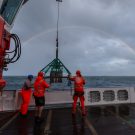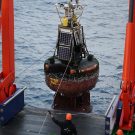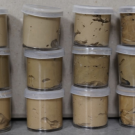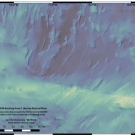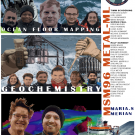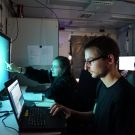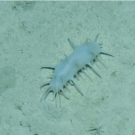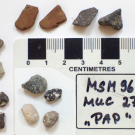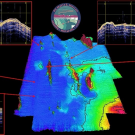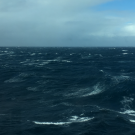— Deutscher Text folgt unten — The geochemistry group leader runs into the mess, shouting “SURPRISE MUC IN 15 MINUTES!”. Our adrenaline levels shoot through the roof. Everyone leaves their coffee/tea behind, we walk rather quickly (no running on deck!), clothes get changed, everyone is on their post. After three weeks on the research vessel, […]
Nachbarschaftshilfe
— Deutscher Text folgt unten — Yesterday our research trip turned into a rescue mission for some time. What had happened? Maybe you remember the heavy storm we reported about at the beginning of our trip, which forced us to change our work area. It was exactly this storm that damaged a long-term ocean observation […]
The mysteries of deep-sea sediments
— Deutscher Text folgt unten — We as geochemists are excited about sediments… and pore water! If you think it is all the same in the deep-sea, you are wrong. The sediments are very diverse and studying this diversity is also the purpose of our cruise. We can already see and feel this – oh […]
Day and Night
— Deutscher Text folgt unten — Nineteen days into the science program we are currently finishing the 57th station of this cruise before heading into a night of mapping again. Since leaving the EEZ of Ireland on October 13th, we have already travelled 2950 nautical miles in total (ca. 5460km) within international waters. We deployed […]
The team
Meet the team of MSM96 – an amazing poster by Palash Kumawat!
Stalk, stalk, stalk.
— Deutscher Text folgt unten — “It’s a metal cage with a couple of cameras being dragged behind the ship, it’s pretty simple” our research group leader said, describing the OFOS (Ocean Floor Observation System), with a smirk on his face, well knowing that bringing such equipment down to the seafloor makes things get difficult […]
The cuteness-scale
— Deutscher Text folgt unten — Since the dawn of time mankind was driven by the question “How cute is this thing?”. Countless devices were invented specifically to answer this question. Objects resembling lenses date back 4000 years ago. These early microscopes were used to determine the cuteness factor of very small objects (ref. https://en.wikipedia.org/wiki/Microscope). […]
Pebbles in deep-sea sediments
— Deutscher Text folgt unten — As described by my colleague Palash, we are collecting sediment with the Multicorer (MUC). Typical deep sea sediment is greyish-brownish, sticky mud. Like the stuff used for making pottery. Deep-sea sediment generally consists of very fine particles: carried from land into the ocean, either by rivers or by wind-blown […]
Beyond the seafloor
During the MSM96 METAL-ML cruise, we are collecting sub-bottom (SBP) data to a depth down to 50m from the seafloor in an effort to understand the recent sedimentological processes that control the sediment distribution inside the study area. Already from the first records, we realized that the “PAP” (Porcupine Abyssal Plain) working area has a […]
Alter course
— Deutscher Text im Anschluss — The North Atlantic has shown us its power and beauty this week. It reminded us, that we have to follow his rules and can be grateful for the opportunities to study whenever the wind and waves allow us to do so. This week, we experienced why few research cruises […]
